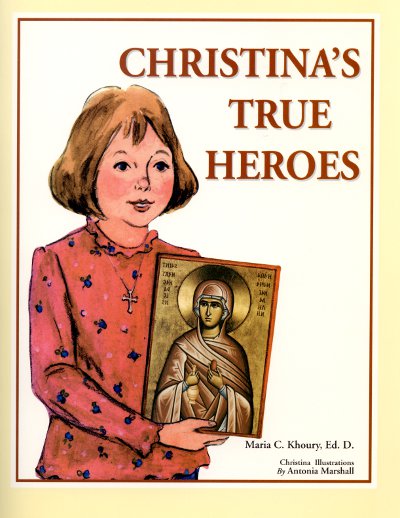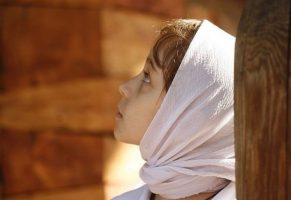Little children start learning to read by being read to aloud. Most often they learn to read from their parents and brothers and sisters. I believe that I developed a love for reading listening to my mother read small booklets she had brought with her from Greece to Denver, where we were living. Every afternoon or so, I recall laying around on my back, relaxing, and listening intensely to my mom read out loud from a worn-out book that did not even have any colorful pictures. But all of the stories talked about Jesus Christ, our Lord and Savior. My mother’s deep faith in Christ was revealed to me by listening to her read about the miracles and the parables during our Lord’s short time on earth. Once in a while she also read a story about a princess or two. Again, there were no photos, just the illustration on the book cover.
 I finally became a mother myself and wanted to read to my daughter Elena. I don’t think it had anything to do with my beloved mother, but rather with the strange obsession to be part of the middle class in Boston where I had started my own family. I simply wanted to introduce my child to every aspect of the world. I had been greatly influenced by the Montessori system, which holds that the brain of the child is like a sponge that quickly and easily soaks up all kinds of information.
I finally became a mother myself and wanted to read to my daughter Elena. I don’t think it had anything to do with my beloved mother, but rather with the strange obsession to be part of the middle class in Boston where I had started my own family. I simply wanted to introduce my child to every aspect of the world. I had been greatly influenced by the Montessori system, which holds that the brain of the child is like a sponge that quickly and easily soaks up all kinds of information.
Every week at the Brookline Public Library after Library Hour, I would see all of the young Jewish mothers going home with large stacks of books that they could hardly carry. Most of these educational books reflected the values and traditions of the Jewish faith. I would flip through those colorful books myself and be enlightened about Jewish celebrations, like Yom Kippur, about which I knew nothing, since I grew up in a very strict traditional Greek Orthodox immigrant home. Of course, there was absolutely nothing on the library shelves about the Eastern Orthodox Faith. Even after searching all of the religious bookstores at Holy Cross [Seminary] and the Religious Education Department on the campus of Hellenic College, where I had been a student, I could only find one children’s Orthodox Christian book to take home. This was Spero’s Gift to God.
After reading to my preschool child far too many books like Spot Goes to the Farm and Amy Goes to the Dentist Office, I felt there was something missing. I needed spiritual books that would prepare my child for life and strengthen her life in Christ. I needed to preserve and pass on something of my Orthodox identity, with its centuries old values and traditions. I sensed I needed more books about the Orthodox faith, since our faith in God shapes our character and our habits. I wanted to hold a visual image in my hands to capture the attention of my child and to tell the simple truths about God’s love for humanity.
My child’s own curiosity about the symbolism of the Orthodox Church kept me listening to all the “why” questions. At the age of two, any statement you make to a child is always followed by a “Why?” This natural need to explain to my own children, Elena, Canaan and Constantine, the beauty of the Orthodox faith led to the first book in the Christina Series, Christina Goes to Church. I published this book because I thought it would be great for parents to use it at home to stimulate questions about faith. I thought, too, that it could be used in the classroom as a visual aid to get or to keep the children’s attention as the teacher explained basic truths of the Orthodox Faith. I was simply a firm believer that through reading, children would grow closer to God. All of my educational research confirmed this intuition. Whether the reading takes place at home or in the classroom, the end result is to inspire others to draw close to God.
As children naturally learn their ABC’s and 123’s, so they naturally grow closer and closer to God reading spiritual books. Thus the idea developed for the second and third books, You are Special: An Alphabet Book for Children, and My Orthodox Counting Book. From the very start, I felt that a preschool child could have an Orthodox book in their backpack and show it to their soccer coach, piano teacher, friends and others, and without a word declare, “This is what I am about, I am an Orthodox Christian.” Christina, the character in my book, was created with a lot of thought, in collaboration with Antonia Marshall, a professional graphic designer in the Boston area, to be the ultimate Orthodox Christian child. She was to be a role model, inspiring every child to imitate her efforts to practice the true Orthodox Faith. With my return to the Holy Land in 1995, it was not possible for Toni to illustrate all eight of the Christina Books. Still, it was a great blessing to keep the same artist for three books, and then to find other local artists in Palestine to help with the creative task.
Reading is important at home because it means that parents and children share “quality time.” Teachers can foster this by recommending to parents publications that are spiritually enriching. With the high cost of Orthodox books, it is wonderful that many churches have libraries from which parents can borrow books, taking turns on different Sundays and returning the books the following Sunday. Promote reading by making sure that your Church has a good collection of Orthodox children’s books. Once a month, the teacher could read an introductory page or main theme from a book that is available in the library and could recommend that particular book for parents to take home. Thus the child would see the cover and have an introduction to the book in the classroom. Carrying the book between the Church and home would make the child responsible for it. I think that these connections and associations can be something like “falling in love” with the book.
These suggestions assume that you already have a Church library. If you need to create one from scratch, you can: you only need a small area that can be secured, perhaps a corner somewhere, or cabinet bookshelves with lockable glass doors. If space is a problem, you might try making a set of bookshelves on wheels, kept in the Church office and brought out during Sunday school lessons, and moved from classroom to classroom. Everything takes commitment and lots of energy, but it can be done with God’s help.
Have you ever thought about your Church school teacher assigning reading? This is so normal in day school, of course, but I was too scared as a Church school teacher to recommend that parents read to their children at home. I thought it was too much of a burden; it was enough that parents would bring their children to Church. Now that I know the great benefits of bed-time reading, however, I think it is a must for teachers to recommend spiritual selections in reinforcing Orthodox identity, especially since children’s books usually make the theological words much easier to understand.
In a society where people are becoming obsessed with television, computers and the Internet, it is almost necessary for Orthodox educators to promote spiritual growth through reading and to remind our students that “we are not of this world.” Along with our heroes in the world, it is also important to know the champions of the One True Faith. Once a month, teachers could assign for reading at home those parts of books like Christina’s Favorite Saints and Christina’s True Heroes that describe the lives of saints that we are currently commemorating in our worship. The colorful Byzantine icons or the pictures would help children know more about the diverse lives of saints. The task of the Sunday school teacher is to remind the child to stay Christ-centered.
Let us take as an example the story of St. Catherine, whom we remember in November. The whole class could be assigned to read the story of her life at the beginning of the month. Sunday after Sunday the teacher could ask the children for one simple fact that they remember from her story. To help the children remember the story, the teacher could ask the student to bring the book containing her story to class. The child could take pride in what he or she has read. The teacher might ask the students to find another icon, photo or an article about St. Catherine to bring into the classroom to encourage them to remember the saint.
The collection of material brought in by the children could be placed in a special corner of the classroom, if space allows, or taped up on a board. Each student could contribute one sentence of what they remembered from the reading, and their name could be written down with the sentence. This would be a great way to review the life of the saint that month, based on reading done at home by the student and by the teacher in the classroom as well. To help the reading contribute to spiritual growth, the teacher could ask the child to have more than one person read the story with him or her (mom, dad, brother, sister, grandmother, grandfather, godmother, godfather, cousin, aunt, uncle, and so forth). While one person may stand out as more influential in our spiritual growth, if the family is closely connected many can contribute.
The bottom line is that educators can help parents establish weekly, if not daily, reading routines. When the reading reflects Orthodox theology or the lives of the saints, it is food for the soul. Reading Orthodox literature is one way to open your heart to our Lord and Savior. Thus when we hear Christ saying in the Gospel, “Let the little children come to me,” and we know that we can be close to God by practicing the sacraments, it is worthwhile to draw them close to God through Orthodox literature.
Children naturally grow closer to God as they read more about the lives of saints, stories with the message of God’s love for humanity, and the Gospel message that Christ our Lord gives eternal life. The ultimate message of any religious story we read to children is that “God loves you.” When children are empowered by God’s love, they grow closer and closer to God by the grace of the Holy Spirit. They will feel spiritually and psychologically empowered to achieve their fullest potential in life, with the goal of giving themselves wholly to God



















